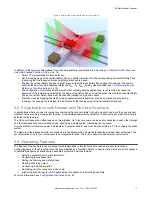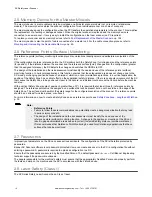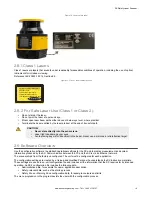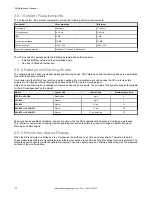
Outward Needle- and Cone-Shaped Field Contours
— An object equal to or greater than the stated resolution (e.g., 70
mm) will be detected at point A (Object 1), because enough sensing points are present at that location to detect the full 70
mm size of the object.
Objects 2 or 3 may not be identified as being larger than the resolution because at that distance, the angle is too narrow (and
has too few sensing points) to detect the full 70 mm resolution size.
Inward Needle- and Cone-Shaped Field Contours
— The effect of an inward cone-shape is to increase the effective
resolution immediately adjacent to the shape. For the Scanner to identify that an object is equal to or greater than the stated
resolution (e.g., 70 mm), the entire object must be within the Safety Zone to turn OFF the OSSDs (e.g., Object 4). When an
object enters the unmonitored cone-shaped area, the start/restart inhibit function will enable a reset as soon as the object
portion within the Safety Zone is smaller than the stated resolution (Objects 5 and 6). This will turn ON the OSSDs if the
configuration is set to automatic restart, or if the reset switch is actuated.
To prevent a safety distance that is too short at that point, the increased effective resolution must be used to determine the
Dpf or C factor in the respective safety distance formulas. If a cone-shaped field must be used and the safety distance cannot
be complied with, additional supplemental safeguarding must be used.
To verify Safety Zone effectiveness, perform a trip test.
Figure 19. Example of inward and outward cone-shaped fields
A
B
A
B
1
2
3
4
5
6
3.2.2 Adjacent SXs
WARNING:
•
Interference from Adjacent SXs
•
Interference from adjacent SXs may cause the OSSDs to go to the OFF state.
•
SXs with a clear line of sight to another SX and that share the same detection plane with it, must
be adjusted or shielded so that their light pulses are not detected by the adjacent SXs.
The SX design minimizes the possibility of optical interference from adjacent Scanners. Light from adjacent scanners
(including those of other manufacturers) can cause OSSDs to go to the OFF state. To eliminate the possibility of optical
interference causing the OSSDs to turn off:
•
Install mechanical shielding/barriers in stationary applications (both horizontal and vertical Safety Zones).
•
For scanners mounted side-by-side, this shielding must be at least at the height of the front screen (window) and
flush with the front of the housing.
◦
Ensure that the means of shielding does not create any unmonitored areas.
◦
Install SXs at an off-set height greater than the height of the scanner output window (60 mm).
•
Install SXs with Safety Zones with a crossed alignment.
Figure 20. Scanners mounted at different scanning angles
Figure 21. Scanner mounted at different scanning heights
≥ 0 mm
SX Safety Laser Scanner
www.bannerengineering.com - Tel: + 1 888 373 6767
29
















































